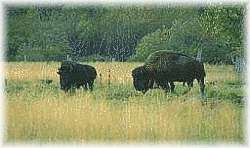Tallgrass Prairie Preserve
category : Nature Preserves
 Originally spanning portions of 14 states and covering over 142 million acres, the tallgrass prairie was one of North America's major ecosystems. Today, less than 10% of the original tallgrass prairie remains. Large, unbroken tracts of tallgrass prairie only exist now in the Flint Hills of Oklahoma and Kansas. As a functioning ecosystem, the tallgrass prairie is extinct.
Originally spanning portions of 14 states and covering over 142 million acres, the tallgrass prairie was one of North America's major ecosystems. Today, less than 10% of the original tallgrass prairie remains. Large, unbroken tracts of tallgrass prairie only exist now in the Flint Hills of Oklahoma and Kansas. As a functioning ecosystem, the tallgrass prairie is extinct. In 1989, The Nature Conservancy purchased the 30,000 acre Barnard Ranch north of Pawhuska, Oklahoma as the cornerstone of the Tallgrass Prairie Preserve which now spans over 37,000 acres. The Conservancy's goal is to recreate a functioning tallgrass prairie ecosystem using fire and bison. Fire has been reintroduced to the landscape by using carefully controlled, or "prescribed" burns. Burns are conducted at different times of the year to mimic the original seasonality of presettlement fires. Fire removes dead vegetation, controls encroaching woody vegetation, and increases the vigor and flowering of many plant species. Grazing, by bison, was also one of the primary natural forces that shaped and sustained the presettlement tallgrass prairie. In 1993, the Conservancy reintroduced a herd of 300 bison to the prairie which will grow to a herd of 2,000 animals freely roaming the Preserve.
Sweeping vistas of the open prairie landscape along with incredible sunrises and sunsets are just some of the many natural attractions at the Tallgrass Prairie Preserve. Wildflowers bloom throughout the growing season with peak periods in Spring and late Summer. Over 500 plant species have been identified on the preserve. The namesake tallgrasses, big bluestem, Indiangrass and switchgrass, can grow as tall as 8 feet in moist, deep soil sites. Maximum height is reached in August and September. A diversity of grassland and forest habitats provides excellent birding. Greater prairie chickens boom in April and May. Numerous breeding birds can be seen in the Spring, as well as birds of prey (including bald eagles). The bison calving season runs from April through June; peaking in May. Other common wildlife species include white-tailed deer, bobcats, armadillos, beavers, woodchucks, badgers, coyotes and numerous small mammals.
Enjoy driving through the Tallgrass Prairie Preserve. A scenic route on public county roads takes visitors through the heart of the preserve. Starting and returning in Pawhuska, the drive is approximately 35 miles, and takes about 2 hours at a leisurely pace. Four scenic turnouts are located along the route. A self-guided nature trail is located near the preserve headquarters. Hikers can take the short loop (1 mile) or the long loop (adds 2 miles). Picnicking is allowed near the preserve headquarters. Camping, hunting and fishing are not allowed on the preserve.
The headquarters of the preserve is in the historic Barnard Ranch Bunkhouse where Ben Johnson entertained the "Duke", John Wayne. The prairie is a popular film location for major motion picture companies.
Address: Located 17 miles North of Pawhuska onTallgrass Dr.
Phone: 918-287-4803
Fax: 918-287-1296
The preserve is open dawn until dusk, every day of the year. From mid-March through October, the Preserve Headquarters is staffed by volunteers on weekends and some weekdays from 10 a.m. to 4 p.m. There is no admittance fee.
Visit the Conservancy web site to find out how to Adopt-a-Bison for only $35.00. More thay 300 bison now roam the Tallgrass Prairie because of this program.
Tallgrass Prairie Preserve
P.O. Box 458
Pawhuska, OK 74056
Come visit us in Pawhuska, Oklahoma
